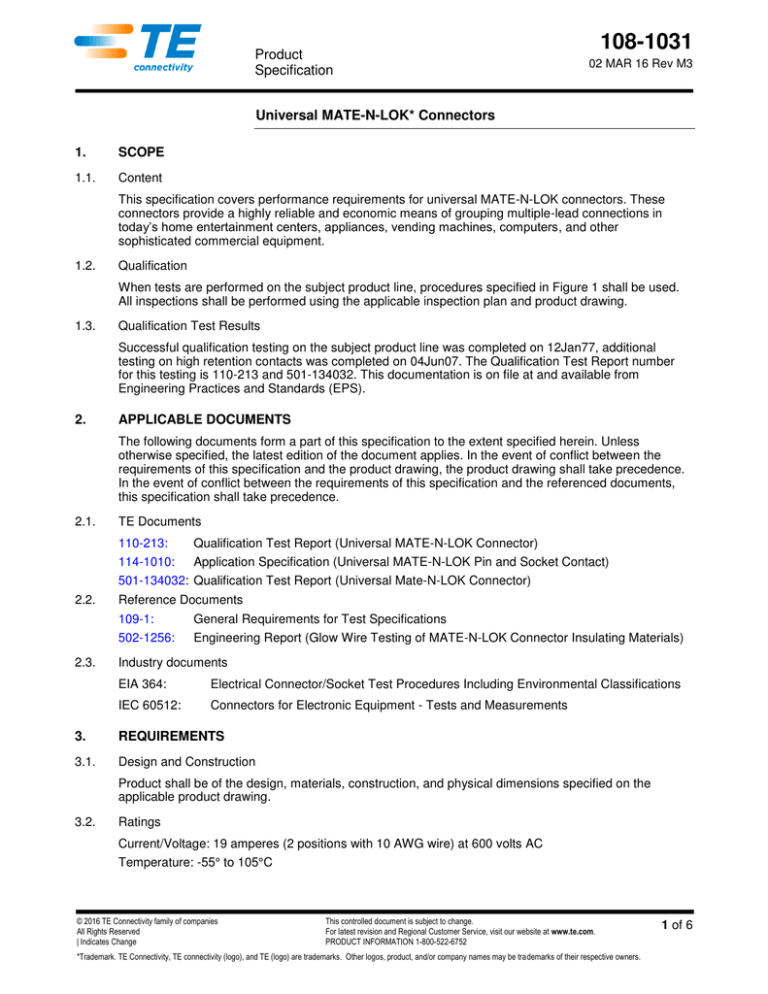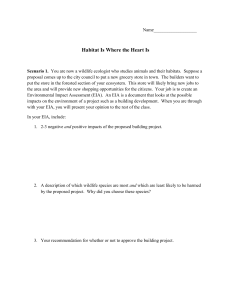
Product
Specification
108-1031
02 MAR 16 Rev M3
Universal MATE-N-LOK* Connectors
1.
SCOPE
1.1.
Content
This specification covers performance requirements for universal MATE-N-LOK connectors. These
connectors provide a highly reliable and economic means of grouping multiple-lead connections in
today’s home entertainment centers, appliances, vending machines, computers, and other
sophisticated commercial equipment.
1.2.
Qualification
When tests are performed on the subject product line, procedures specified in Figure 1 shall be used.
All inspections shall be performed using the applicable inspection plan and product drawing.
1.3.
Qualification Test Results
Successful qualification testing on the subject product line was completed on 12Jan77, additional
testing on high retention contacts was completed on 04Jun07. The Qualification Test Report number
for this testing is 110-213 and 501-134032. This documentation is on file at and available from
Engineering Practices and Standards (EPS).
2.
APPLICABLE DOCUMENTS
The following documents form a part of this specification to the extent specified herein. Unless
otherwise specified, the latest edition of the document applies. In the event of conflict between the
requirements of this specification and the product drawing, the product drawing shall take precedence.
In the event of conflict between the requirements of this specification and the referenced documents,
this specification shall take precedence.
2.1.
TE Documents
110-213:
Qualification Test Report (Universal MATE-N-LOK Connector)
114-1010:
Application Specification (Universal MATE-N-LOK Pin and Socket Contact)
501-134032: Qualification Test Report (Universal Mate-N-LOK Connector)
2.2.
2.3.
Reference Documents
109-1:
General Requirements for Test Specifications
502-1256:
Engineering Report (Glow Wire Testing of MATE-N-LOK Connector Insulating Materials)
Industry documents
EIA 364:
Electrical Connector/Socket Test Procedures Including Environmental Classifications
IEC 60512:
Connectors for Electronic Equipment - Tests and Measurements
3.
REQUIREMENTS
3.1.
Design and Construction
Product shall be of the design, materials, construction, and physical dimensions specified on the
applicable product drawing.
3.2.
Ratings
Current/Voltage: 19 amperes (2 positions with 10 AWG wire) at 600 volts AC
Temperature: -55° to 105°C
© 2016 TE Connectivity family of companies
All Rights Reserved
| Indicates Change
This controlled document is subject to change.
For latest revision and Regional Customer Service, visit our website at www.te.com.
PRODUCT INFORMATION 1-800-522-6752
*Trademark. TE Connectivity, TE connectivity (logo), and TE (logo) are trademarks. Other logos, product, and/or company names may be trademarks of their respective owners.
1 of 6
108-1031
3.3.
Test Requirements and Procedures Summary
Unless otherwise specified, all tests shall be performed at ambient environmental conditions.
Test Description
Examination of Product
Termination Resistance
Requirement
Procedure
Meets requirements of product
drawings and 114-1010.
Wire Size
Test
Initial
(mm2
Current Resistance
[AWG])
(amps) (Maximum)
0.05 [30]
0.5
4.00
0.09 [28]
0.7
3.75
0.13 [26]
0.9
3.75
0.2 [24]
1.5
3.50
0.3 [22]
3.0
3.50
0.5 [20]
4.5
3.00
0.8 [18]
6.0
3.00
1.3 [16]
8.0
2.75
2.1 [14]
10.0
2.75
3.3 [12]
16.0
2.50
5.3 [10]
24.5
2.50
Visual, dimensional, and functional
per applicable inspection plan.
EIA 364-6B and IEC 60512-2-2
Measure potential drop of mated
contacts. Calculate resistance
(without bulk wire resistance). See
Figure 2.
Termination Resistance, Dry Circuit
3.5 milliohms maximum initial.
6.0 milliohm maximum final.
EIA 364-23, Condition A
Subject mated contacts assembled
in housing to 20 millivolt maximum
open circuit at 100 milliamperes
maximum. See Figur.
Dielectric Withstanding Voltage
5.09 kVAC dielectric withstanding
voltage.
EIA 364-20B and IEC 60512-4-1
1-minute hold with no breakdown or
flashover.
Insulation Resistance
1000 megaohms minimum initial.
100 megaohms minimum final.
EIA 364-21C and IEC 60512-3-1
500 V DC input
Test between adjacent circuits of
free hanging connector.
Temperature Rise vs Current
See Notes (a) and (c). For
temperature rise, see Figure .
EIA 364-70A and IEC 60512-5-1
Random Vibration
No discontinuities of 1
microsecond or greater.
EIA 364-28, Condition VII, Level E
Frequency Range: 20-500 Hz
Power Spectral Density: 0.05 g²/Hz
(4.90 g)
Duration Each Axis: 15 minutes
Mechanical Shock
No discontinuities of 1
microsecond or greater.
EIA 364-27, Condition A and IEC
60512-6-3
Pulse Type: half sine
Pulse Amplitude: 50 g
Pulse Duration: 11 milliseconds
Figure 1 Cont.
Rev M3
2 of 6
108-1031
Mating Force
Will not exceed 5 lbs average per
contact when fully mated (based
on a sample size of 30 mated,
loaded housings.
6.67 N [1.5 lbf] maximum per
contact for split pins.
EIA 364-13B and IEC 60512-13-1
Measure force necessary to mate
connector assembly with locking
latches removed. Calculate force
per contact.
Un-Mating Force
3.11 N [0.7 lbf] minimum per
contact for solid pins.
2.22 N [0.5 lbf] minimum per
contact for split pins.
EIA 364-13B and IEC 60512-13-1
Measure force necessary to unmate connector assembly with
locking latches removed. Calculate
force per contact.
Contact Insertion Force
22.2 N [5 lbf] maximum per
contact.
EIA-364-5
Measure force to insert contact into
housing.
Contact Retention Force
66.7 N [15 lbf] minimum.
111.2 N [25 lbf] minimum for high
retention contacts.
EIA-364-29 and IEC 60512-15-1.
(except grip wire)
Apply an axial load to contact at a
rate of 12.7 mm [.5 in.] per minute.
Crimp Tensile
Wire Size
(mm2 [AWG])
Crimp Tensile
(N [lbf] Min)
0.05 [30]
6.7 [1.5]
0.09 [28]
8.9 [2]
0.13[26]
13.4 [3]
0.2 [24]
22 [5]
0.3 [22]
36 [8]
0.5 [20]
58 [13]
0.8 [18]
89 [20]
1.3 [16]
134 [30]
2.1 [14]
223 [50]
3.3 [12]
312 [70]
5.3 [10]
356 [80]
EIA 364-8B, IEC 60512-16-4 &
IEC 60512-16-20
Determine crimp tensile at a rate of
25.4 mm [1 in.] per minute.
Durability
See Note (d).
EIA 364-9C and IEC 60512-9-1
Mate and un-mate specimens for 50
cycles at a maximum rate of 500
cycles per hour.
Housing Panel Retention
333.6 N [75 lbf] minimum.
EIA-364-97
Measure panel retention force using
nominal panel cut out dimensions at
a rate of 0.5 in/min.
Housing Lock Strength
133.4 N [30 lbf] minimum after
temperature-humidity cycling.
EIA 364-98
Determine strength of housing
locking mechanism.
Thermal Shock
Dielectric withstanding voltage.
3.75 millohms maximum
termination resistance, dry circuit.
See figure 4
EIA 364-32C and IEC 60512-11-4
Subject mated specimens to 25
cycles between -55 and 85°C.
Figure 1 Cont.
Rev M3
3 of 6
108-1031
Humidity/Temperature Cycling
Dielectric withstanding voltage.
100 megaohms minimum
insulation resistance.
6.0 milliohms maximum
termination resistance, dry circuit.
See Note (b).
EIA 364-31B, Method IV, IEC
60512-11-3 and IEC 60512-11-12
Subject mated specimens to ten 24hour cycles between 25° and 65°C
at 95% RH with a -10°C cold shock
between cycles.
Salt Spray Corrosion
7.0 milliohms maximum
termination resistance, dry circuit.
EIA 364-26B
Subject unmated specimens to 48
hours at 5% concentration.
NOTE
(a) Maximum rated current that can be carried by this product is limited by maximum operating
temperature of housings, which is 105°C and temperature rise of contacts, which is 30°C.
Variables which shall be considered for each application are: wire size, connector size, contact
material, and ambient temperature.
(b) Shall meet visual requirements, show no physical damage, and meet requirements of additional
test as specified in the separable interface testing in test sequence 2.
(c) Temperature rise test currents are based on the test current from the termination resistance test.
The temperature should be measured at 6 relatively evenly spaced currents. Figure 3 suggests
current levels for each wire size.
(d) Shall meet visual requirements, show no physical damage, and meet requirements of additional
tests as specified in the connector tests product qualification and re-qualification test sequences
given in Figure 5.
Figure 1 end
Wire-to-Wire Termination Resistance Measurement Points
A = 1-Foot Minimum Length of Continuous Lead for Heat Dissipation
X = Wire Length in inches
Termination Resistance = (millivolts Test Current) - Resistance of Wire Length
Figure 2
Rev M3
4 of 6
108-1031
Spaced Test Currents for Temperature Rise Testing (amperes)
Temperature
Expectation
Wire Size (mm2 [AWG])
0.05
[30]
0.09
[28]
0.13
[26]
0.2
[24]
0.3
[22]
0.5
[20]
0.8
[18]
1.3
[16]
2.1
[14]
3.3
[12]
5.3
[10]
—
0.13
0.18
0.23
0.4
0.8
1.1
1.5
2.0
2.5
4.0
6.1
—
0.25
0.35
0.45
0.8
1.5
2.3
3.0
4.0
5.0
8.0
12.3
—
0.38
0.53
0.68
1.1
2.3
3.4
4.5
6.0
7.5
12.0
18.4
—
0.50
0.70
0.90
1.5
3.0
4.5
6.0
8.0
10.0
16.0
24.5
Less than 30°C
0.63
0.88
1.13
1.9
3.8
5.6
7.5
10.0
12.5
20.0
30.6
Greater than 40°C
0.75
1.05
1.35
2.3
4.5
6.8
9.0
12.0
15.0
24.0
36.8
Greater than 60°C
Figure 3
Figure 4
Terminal Temperature vs Current/Circuit, Phosphor Bronze Contacts, 4 Circuit Free Hanging Housing
Figure 5
Terminal Temperature vs Current/Circuit, Phosphor Bronze Contacts,12 Circuit Free Hanging Housing
Rev M3
5 of 6
108-1031
3.4.
Product Test Sequence
TEST GROUP (a)
TEST OR EXAMINATION
1
2
3
4
5
6
7
8
1
1
1
TEST SEQUENCE (b)
Initial Examination of Product
1
1
1
1
1
3
Termination Resistance Specified Current
2,4,6,8
3,7
Vibration
3
5
Mechanical Shock
5
6
Termination Resistance Dry Circuit
Dielectric Withstanding Voltage
Insulation Resistance
5,7, 11,13
3,10,15
4,14
Temperature Rise vs Current
2
Mating Force
2
2
Unmating Force
8
8
Contact Insertion Force
2
Contact Retention Force
3
2
Crimp Tensile
Durability
6
4
Housing Panel Retention
2
Housing Lock Strength
16
Thermal Shock
9
Salt Spray Corrosion
7
Humidity/Temperature Cycling
12
Final Examination of Product
17
4
9
3
4
3
9
NOTE
(a) Connector housings and contacts shall be prepared in accordance with applicable instruction sheets
and shall be selected at random from current production.
Test group 1 shall consist of 1 housing of each size: 5 pins and 5 sockets all representative of the
entire lot being tested. Test groups 2 through 4 shall consist of 4 connector assemblies per group. The
housings and wire sizes shall be chosen randomly to cover the range of the product line. Test group 5
samples shall consist of 15 pin and socket contacts per wire size. Test group 6 samples shall consist
of 15 pin and socket contacts crimped on 14 AWG wire and tested with appropriate random housings.
Test group 7 samples shall consist of 15 random housings. Test groups 8 shall consist of enough
contacts and housing to generate 30 data points.
(b) Number indicates sequence of tests performed.
Figure 6
Rev M3
6 of 6




